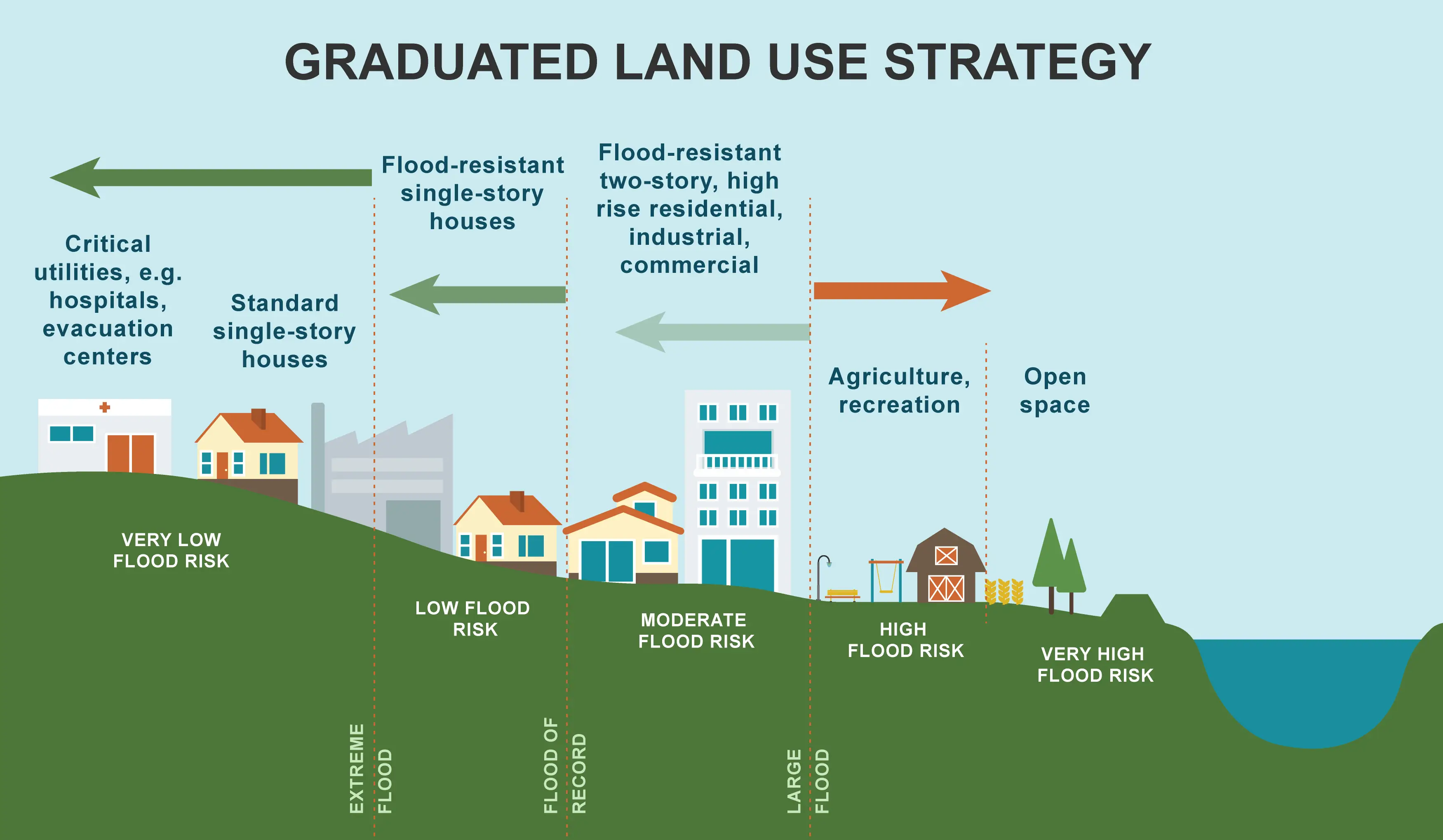
FLOOD BASICS
Flood Mitigation
There are a variety of actions and tools a community or individual can take to minimize the impact of flooding before it happens. These tools work best when used in combination.
Community Solutions
Communities can take action to change how they experience flooding. Common ways communities seek to address flooding include:
-
Removing or modifying structures in areas prone to flooding. For example, moving homes out of flood-prone areas and using that land for parks or open space can allow floodwaters to flow freely and cause minimal damage. Elevating bridges or using permeable materials on roadways can also promote the natural flow and retention of water.
-
Participating in federal programs that can help reduce the cost of protective measures, for example, communities participating in the National Flood Insurance Program can adopt additional measures and see discounts in their insurance premiums through the Community Rating System.
-
Understanding how existing or new infrastructure, such as stormwater systems, concrete highways and sidewalks, or business and housing developments, may contribute to flooding and be modified to improve localized drainage.
-
Encouraging people who live, work, or own a property in an area prone to flooding to purchase flood insurance, know their evacuation route, and practice flood safety through community awareness programs or campaigns.
-
Adopting measures that manage the flow of water, such as by building a berm, levee, floodwall, or a dam. Natural barriers such as dunes, wetlands, or seagrass can also be used.
-
Establishing and testing community notification and response plans to be used in the event of a flood or other emergencies.
-
Establishing laws and requirements for how land can be used and developed in areas prone to flooding.
-
Ensuring newly constructed structures meet current building standards.
-
Engaging the community in decisions that influence flooding.
-
Completing studies to better understand flooding and options to address it.
Multiple Measures Can Be Used to Address Flooding
Communities use multiple measures when planning and addressing flooding. Some communities adopt regulations that do not allow development on land closest to a water source like a river. This space is reserved for community parks, recreation, or agriculture. While some flooding may occur, the damages are minimal and areas closest to the waterway can quickly recover.
Another option communities use is applying up-to-date building codes and retrofitting older structures so that they are flood proof. This might include ensuring lower parts of a home do not obstruct floodwaters, people do not inhabit the lowest part of a structure prone to flooding, critical systems or the house itself are elevated, and that critical structures or facilities, like a water treatment plant or hospital, are not located in areas prone to flooding or are made flood proof.
Communities may also promote individual actions such as purchasing flood insurance, using tools to catch rainwater and improve absorption, and being flood ready by knowing who to listen to in a flood, where to go, and how to stay safe.

Personal Solutions
People who live and work in areas prone to flooding can take actions to minimize the impact should flooding occur.
Some common options people use to address flooding include:
-
Contacting the local floodplain management official who can help identify options to address flooding and make clear any approvals needed or opportunities for support.
-
Obtaining an elevation certificate for the business or home to help determine how susceptible the structure may be to various types of floods.
-
Installing flood vents or similar structures that allow water to flow through or drain out of lower parts of a building susceptible to flooding.
-
Ensuring a building is properly sealed or can be made floodproof in advance of an event by placing sandbags or similar materials.
-
Determining if relocating or raising a structure is needed; this is an option often considered in areas with repetitive flooding and associated damages.
-
Using rain barrels and removing leaves and other debris from gutters to keep water from pooling near a building.
-
Using flood resistant materials in a building such as insulation, drywall, or flooring materials that can easily be cleaned and sanitized.
-
Participating in community-led discussions about how to address flooding.
-
Purchasing flood insurance, even if the property is outside the “base flood.”
-
Regrading land near a building to promote proper drainage.
-
Having a plan to evacuate and stay safe during a flood. Read more at https://www.ready.gov/floods.
-
Elevating utilities, such as furnaces, water heaters, or electrical systems.
See FEMA’s guide to learn more about how to protect a property from flooding.
Did You Know?
There are multiple federal and state level resources that capture best practices and example approaches to address flooding. Climate.gov hosts several case studies that show how communities nationwide have worked to combat multiple disasters and events. Coastal communities may be able to learn from others using the National Oceanic and Atmospheric Administration’s (NOAA) Digital Coast toolbox. FEMA also hosts a collection of stories about communities working to mitigate their flood risks.
No community is alone in its flood experiences – learning how others have addressed flooding is an easy first step.
Next Up
Understand your flood risk.